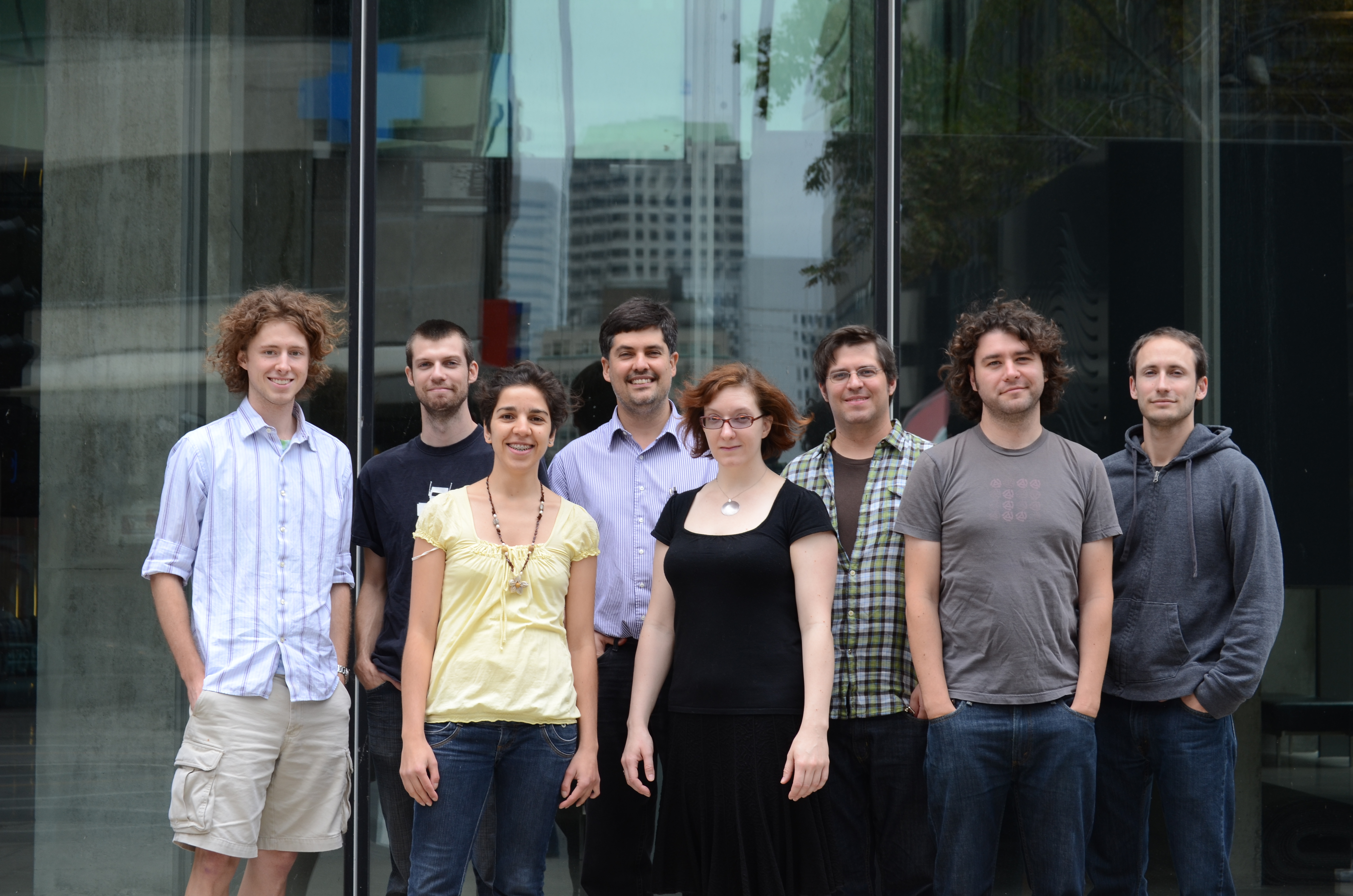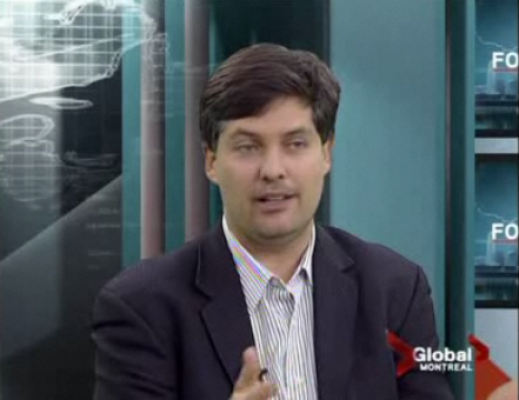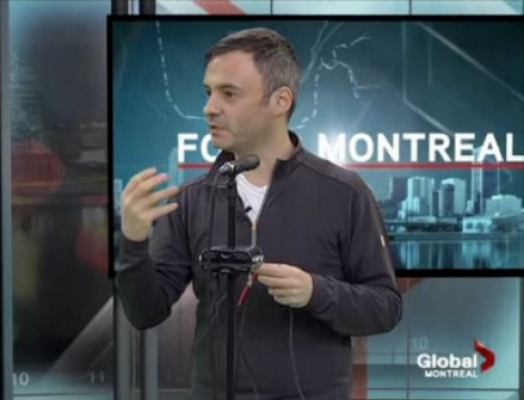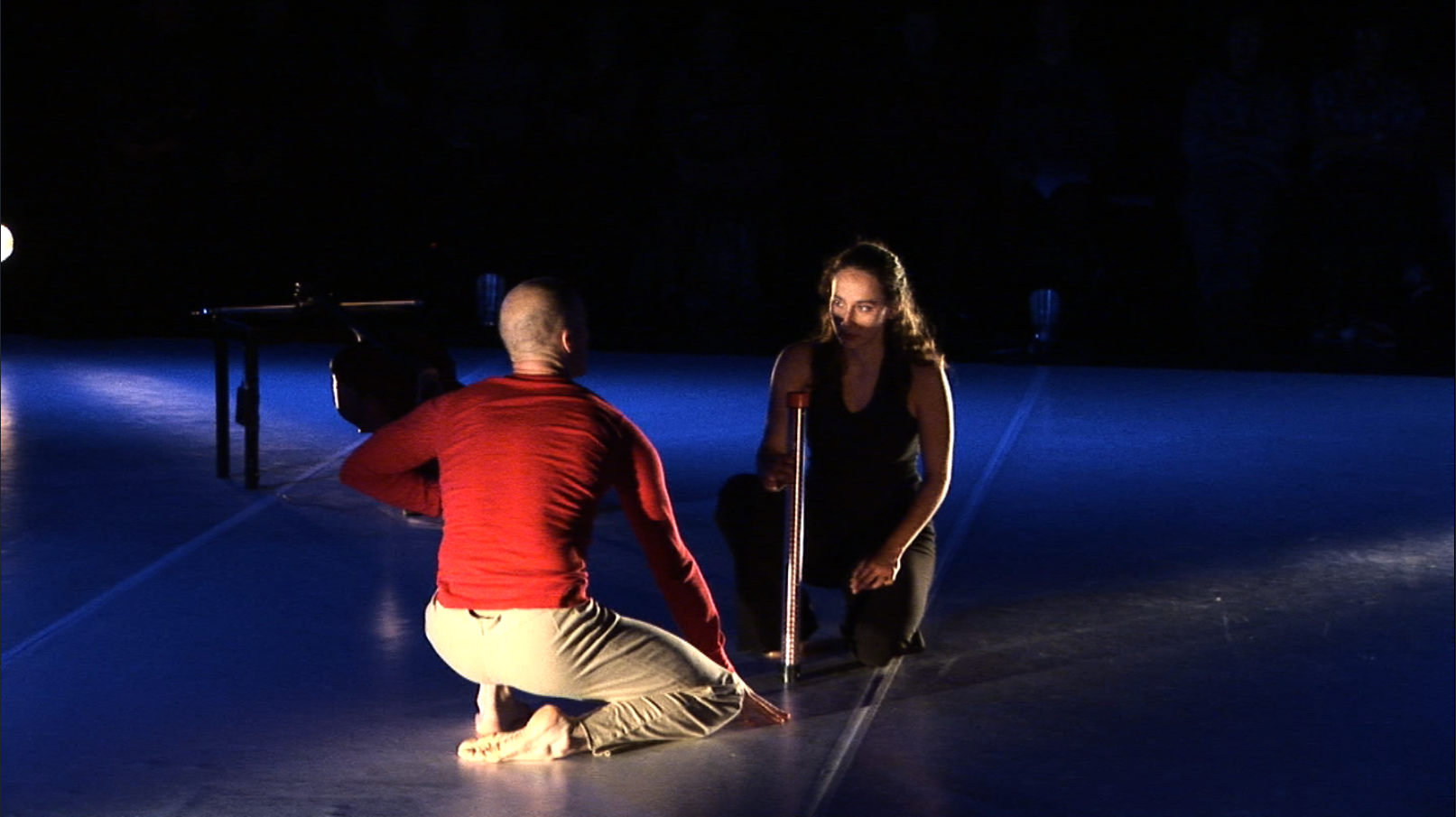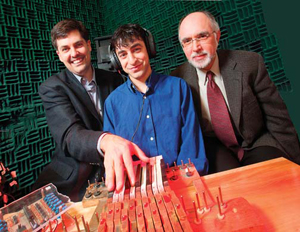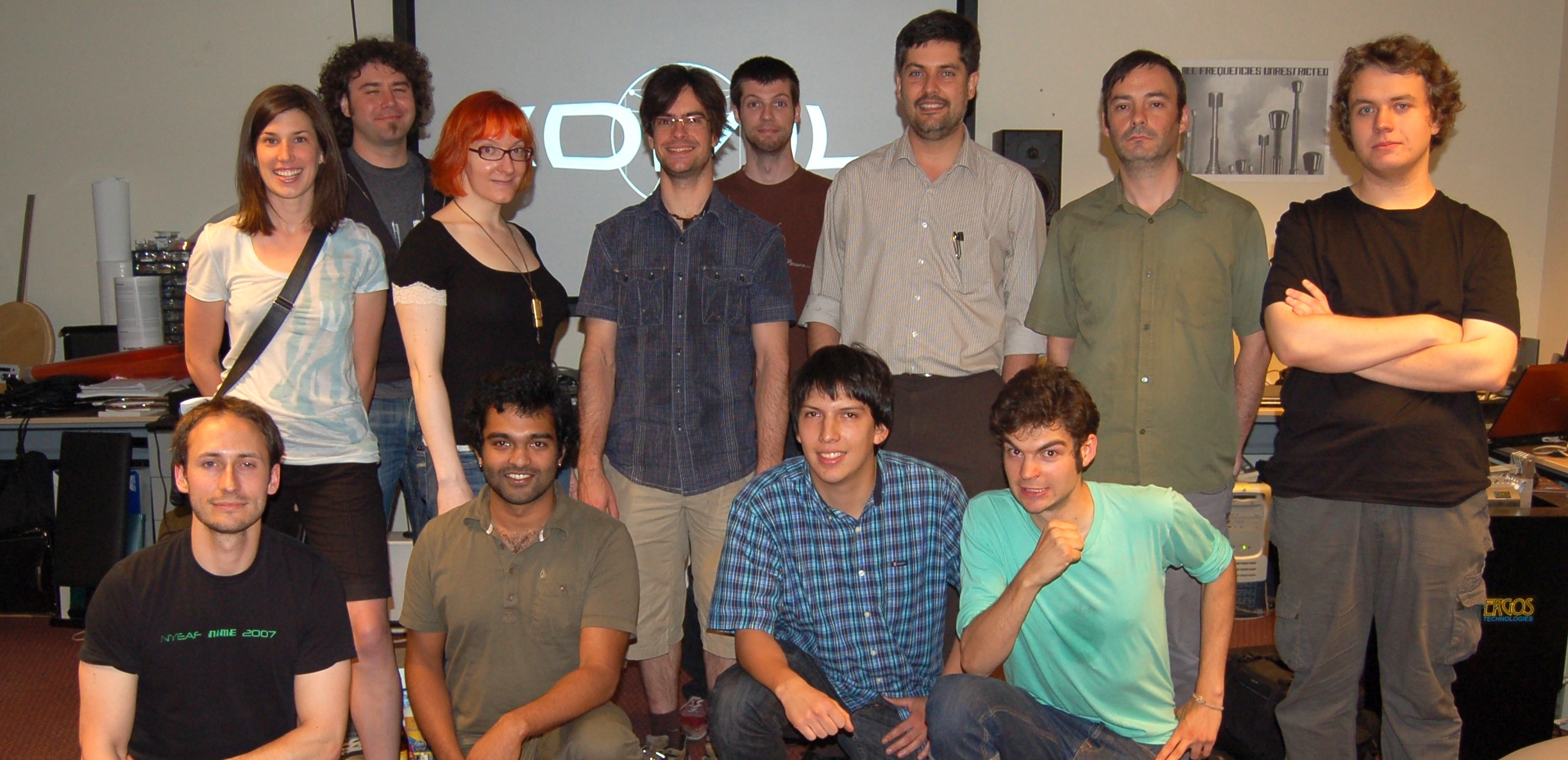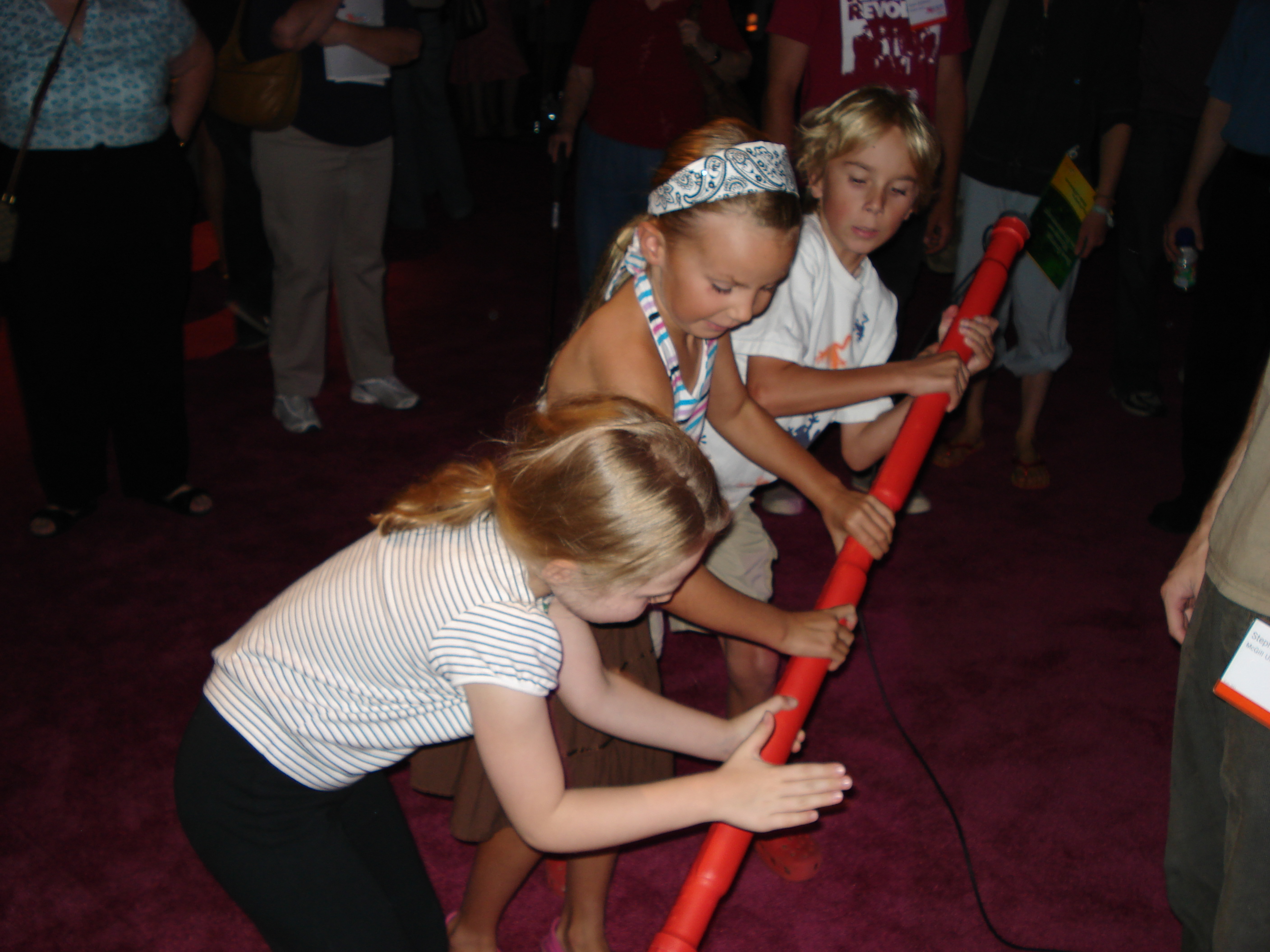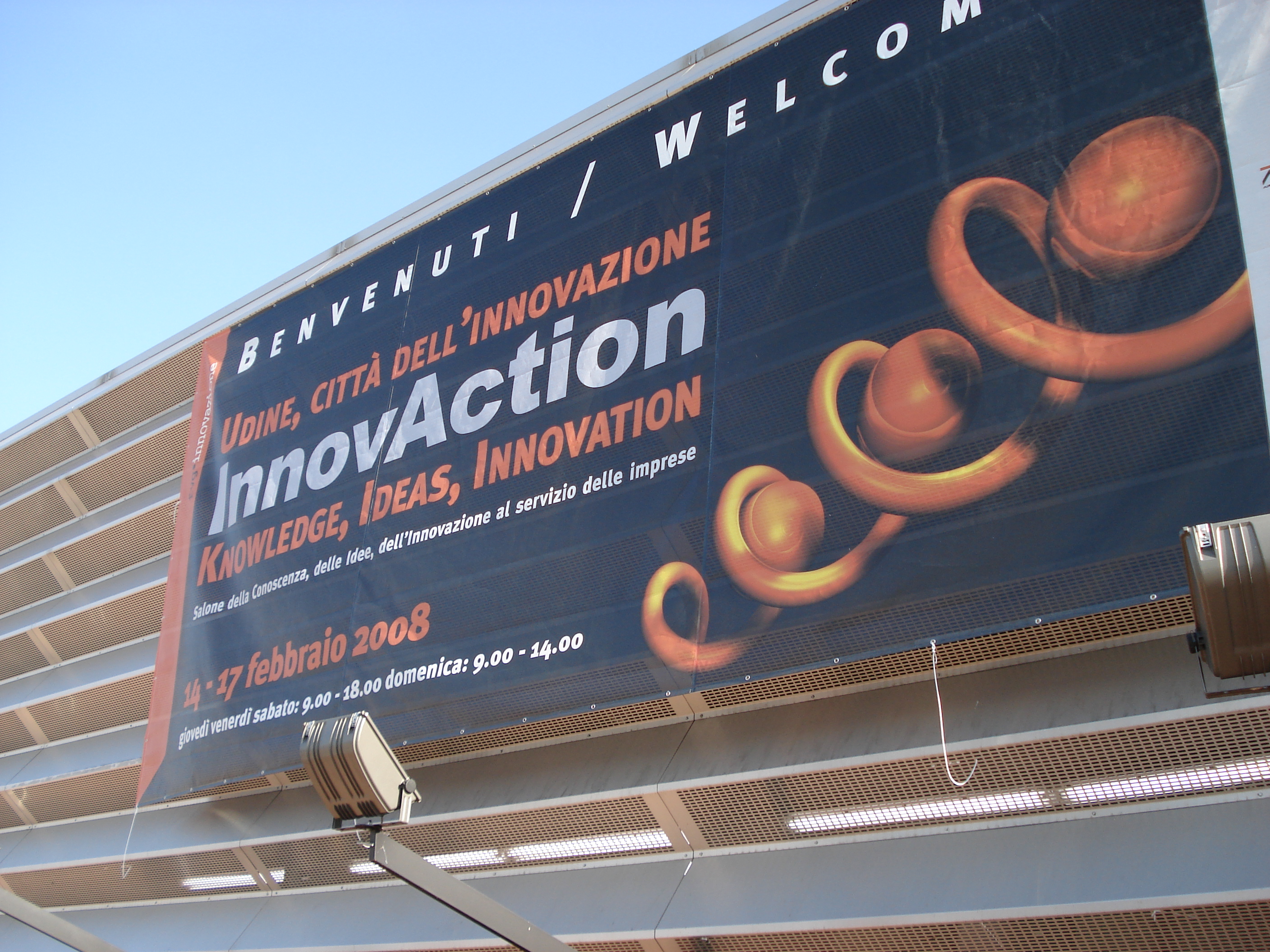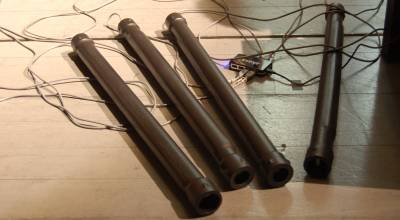IDMIL News!
Les Gestes promo video
Here is a promo video for the Gestes Project. Instrument design, development and construction by Joseph Malloch, Ian Hattwick, and Anthony Piciacchia.
Lab Photo
From left: R. Michael Winters, Stephen Sinclair, Carolina Brum Medeiros, Marcelo M. Wanderley, Vanessa Yaremchuk, Ian Hattwick, Mark Zadel, Joseph Malloch. Missing: Marcello Giordano, Avrum Hollinger, Marlon Schumacher, Erika Donald, Bruno Angeles, Mahtab Ghamsari-Esfahani.
photo by: Scott Levine
Interview about the McGill Digital Orchestra Project
From the Spark Festival of Electronic Music and Arts: an interview with performers Xenia Pestova and Erika Donald, in which they discuss their experience with the McGill Digital Orchestra Project.
Or you can download the video (.flv 128.1 MB) or audio (.mp3 53.4 MB).
Instrumented Bodies article in Gizmag
There is a new article on the Instrumented Bodies project at Gizmag:
Instrumented Bodies gives music and dance some backbone by Paul Ridden (with accompanying image gallery)
Improvisation - Transir for bass flute and soprano t-stick
An improvised duo for bass flute and soprano t-stick at the Centro Mexicano para la Música y Artes Sonoras in Morelia, Mexico (29 June, 2012): Salvador Torre, amplified bass flute, and D. Andrew Stewart, soprano t-stick.
IDMIL Work Featured at Focus Montreal, Global TV
Richard Dagenais, the anchor for the program, interviewed prof. Wanderley and IDMIL graduate students Stephen Sinclair and Gabriel Vigliensoni on the Jan. 8th 2011 edition of Focus Montreal at Global TV.
They presented some of the recent work developed at the IDMIL including the simulation of virtual percussionists (Ph.D. thesis work and post-doc. of Alexandre Bouenard in collaboration with Prof. Sylvie Gibet, University of South Brittany, France), a performance of the T-Stick (Joe Malloch) by D. Andrew Stewart, the simulation of virtual bowing with force-feedback devices (Sinclair) and the SoundCatcher (Vigliensoni).
The video of the program is available at http://www.globalmontreal.com/video/index.html. The IDMIL part of the program starts around 15 minutes.
IDMIL to present research at EuroHaptics 2016 Conference
IDMIL PhD researcher John Sullivan will present recent haptics research at the EuroHaptics 2016 Workshop “Musical Haptics: use and relevance of haptic feedback in musical practice”. The workshop will take place at July 4, 2016 from 9:15 - 13:15 at Imperial College London, UK.
The workshop, organized by Stefano Papetti (Institute for Computer Music and Sound Technology, Zurich University of the Arts, Switzerland) and Ercan Altinsoy (Institute of Acoustics and Speech Communication, Dresden University of Technology, Germany), will include presentations by Vincent Hayward, Gareth Young, Nicolas Castagné, and Edgar Berdahl.
Abstract: Tactile Augmented Wearables for Delivery of Complex Musical Score Information
John Sullivan, Deborah Egloff, Marcello Giordano, Marcelo M. Wanderley
Tactile augmented wearables have been object of much research in recent years, both in academia and industry, and have been used to convey information such as navigational cues or system notifications. In the music domain, tactile wearables have been used to convey simple musical information to performers, in the form of, for instance, tempo cues or instantaneous feedback about the interaction with a live-electronics system. More complex tactile cues can also be designed. “Musicking the body electric” is a multidisciplinary project aiming at developing a set of tactile augmented garments for professional musicians, and a vocabulary of complex tactile icons (“tactons”) to be used by composers to deliver score information. What are the perceptual limitations of delivering complex, whole-body patterns of vibrations to performing musicians? Can musicians learn to reliably recognize icons and associate them to score elements? What are the best strategies for actuator choice and placement? These research questions are at the core of the “Musicking the body electric” project, and offer a cause for a more general reflection on the many issues to be addressed to evaluate abstract languages of tactile icons delivered by specialized wearable devices.
See the full workshop program here.
A Comprehensive Review of Sensors and Instrumentation Methods in Devices for Musical Expression
Now available online: Carolina Brum Medeiros and Marcelo M. Wanderley (2014). A Comprehensive Review of Sensors and Instrumentation Methods in Devices for Musical Expression. Sensors Journal 14, no. 8: 13556-13591.
Abstract:
Digital Musical Instruments (DMIs) are musical instruments typically composed of a control surface where user interaction is measured by sensors whose values are mapped to sound synthesis algorithms. These instruments have gained interest among skilled musicians and performers in the last decades leading to artistic practices including musical performance, interactive installations and dance. The creation of DMIs typically involves several areas, among them: arts, design and engineering. The balance between these areas is an essential task in DMI design so that the resulting instruments are aesthetically appealing, robust, and allow responsive, accurate and repeatable sensing. In this paper, we review the use of sensors in the DMI community as manifested in the proceedings of the International Conference on New Interfaces for Musical Expression (NIME 2009–2013). Focusing on the sensor technologies and signal conditioning techniques used by the NIME community. Although it has been claimed that specifications for artistic tools are harder than those for military applications, this study raises a paradox showing that in most of the cases, DMIs are based on a few basic sensors types and unsophisticated engineering solutions, not taking advantage of more advanced sensing, instrumentation and signal processing techniques that could dramatically improve their response. We aim to raise awareness of limitations of any engineering solution and to assert the benefits of advanced electronics instrumentation design in DMIs. For this, we propose the use of specialized sensors such as strain gages, advanced conditioning circuits and signal processing tools such as sensor fusion. We believe that careful electronic instrumentation design may lead to more responsive instruments.
IDMIL theses available online
We have added a list of theses done at the IDMIL as well as links to the PDF documents of their final versions.
Please check the publications page for more.
IDMIL technology in concert
IDMIL technology has appeared in several live@CIRMMT concerts and events over the past week:
- A sensing system using piezo-electric contact microphones on a percussionist's fingertips was used in Steven Schick's performance of Chatter/Clatter, part of composer Roger Reynolds' Sanctuary Project.
- Custom control hardware built by Mark Marshall was used in an updated performance of Karlheinz Stockahausen's Mantra by Xenia Pestova and Pascal Meyer.
- An adapted version of the T-Stick digital musical instrument was used to control processing and spatialization of live sound in four performances of Duo pour un violoncelle et un danseur, a new collaborative work by Sean Ferguson and Isabelle Van Grimde/Corps Secrets
IDMIL Researchers at the Workshop "Haptics and musical practice"
Prof. Marcelo M. Wanderley and Ph.D. student Deborah Egloff participated in the Workshop “Haptics and musical practice”, that took part on February 4-5 2016 at the Institute for Computer Music and Sound Technology, Zurich University of the Arts, Zurich, Switzerland.
They were part of a group of researchers from Switzerland, Italy, Austria, France, Scotland, Germany who research haptics and music.
The full program is available at the Workshop webpage.
IDMIL researchers at CNMAT, University of California Berkeley
Prof. Marcelo Wanderley and Dr Baptiste Caramiaux will be at the Center for New Music and Audio Technologies (CNMAT), University of California, Berkeley, on May 6th, 2016. In the morning, Baptiste will give a talk jointly with Frédéric Bevilacqua from IRCAM on Movement and Sound Interaction, a research overview from music performance to motor cognition. In the afternoon, Marcelo will give a lecture on research conducted at CIRMMT.
Details are available on the CNMAT website: http://cnmat.berkeley.edu/
IDMIL Project at McGill Headway Magazine
Avrum Hollinger's work is featured in the latest issue of McGill's Headway Magazine, a collaboration with Profs. Robert Zatorre and Virginia Penhune.
Avrum Hollinger (middle), a graduate student in Marcelo Wanderley's (left) electrical engineering lab, built a metal-free keyboard that can be played inside a highly magnetic MRI machine. The special instrument now makes it possible for neuroscientist Robert Zatorre (right) to monitor musicians' brain activity while they play.
IDMIL @ NIME2011
Several IDMIL projects were represented at this year's International Conference on New Interfaces for Musical Expression, including:
- A three-hour workshop on the open-source mapping library libmapper
- Presentation of the paper “Examining the Effects of Embedded Vibrotactile Feedback on the Feel of a Digital Musical Instrument” by Mark T. Marshall and Marcelo M. Wanderley
- A solo performance on the soprano T-Stick by composer/performer D. Andrew Stewart
- A trio performance featuring IDMIL student Erika Donald
IDMIL symposium photo
Group photo of the participants in the IDMIL symposium (Photo credit: Moonseok Kim).
Back row, from left: Erika Donald, Mark Zadel, Vanessa Yaremchuk. Steven R. Livingstone, Stephen Sinclair, Marcelo M. Wanderley, Gabriel Vigliensoni, Jerôme Nika.
Front row, from left: Joseph Malloch, Vijay Rudraraju, Bruno Angeles, Joseph Thibodeau.
Missing: Avrum Hollinger, Marc Thompson.
IDMIL instruments at Wired Nextfest
Several digital musical instruments from the IDMIL were displayed and demonstrated at WIRED Magazine's Nextfest September 13–16 at the Los Angeles Convention Center. Among them were the T-Stick, the Rulers, the Tralf (now the “T-box”), and a pair of sensor-equipped gloves. IDMIL researchers Stephen Sinclair and Joseph Malloch attended, along with DCS director Sean Ferguson, to demonstrate how DMIs are being used in the context of the McGill Digital Orchestra project. The press release can be viewed here.
IDMIL instruments at Innovaction in Italy
The T-Stick and Gyrotyre digital musical instruments, both developed in the IDMIL, were displayed and demonstrated February 14-17 at the Innovaction fair of “knowledge, ideas and innovation” in Udine, Italy. Lab director Marcelo M. Wanderley and doctoral student Joseph Malloch attended. According to the final press release from the organizers, over 45 000 visitors attended Innovaction this year.
IDMIL in Jyväskylä
R. Michael Winters presented two IDMIL research projects at the International Conference on Music and Emotion in Jyväskylä Finland June 11-15th. Mike was the recipient of a CIRMMT student travel award and a SEMPRE award to attend this conference. The first paper was a collaboration between IDMIL and Emotional Imaging Incorporated and is entitled “Emotional Data in Music Performance: Two Audio Environments for the Emotional Imaging Composer” and was co-written with Ian Hattwick and Marcelo M. Wanderley. The second paper “Sonification of Emotion: Strategies for Continuous Auditory Display of Arousal and Valence” was co-written with advisor Marcelo M. Wanderley.
2010 T-Stick Composition Workshops
website: http://tcw2010.wordpress.com/
The 2010 T-Stick Composition Workshops (2010TCW) bring together five composers (any nationality, all ages) to develop new live electroacoustic solos for the soprano t-stick digital musical instrument in collaboration with Canadian composer and digital instrumentalist, D. Andrew Stewart. Selected composers will work individually with D. A. Stewart, being introduced to the present-day modes of performance on the soprano t-stick. The workshops will focus on exploring musical and physical playing gestures and will also include the development of new playing techniques and sounds for the instrument. The outcome of the workshops will be five new solo works for the soprano t-stick. The works will be performed by D. Andrew Stewart in a series of Canadian concerts beginning in January, 2011.

